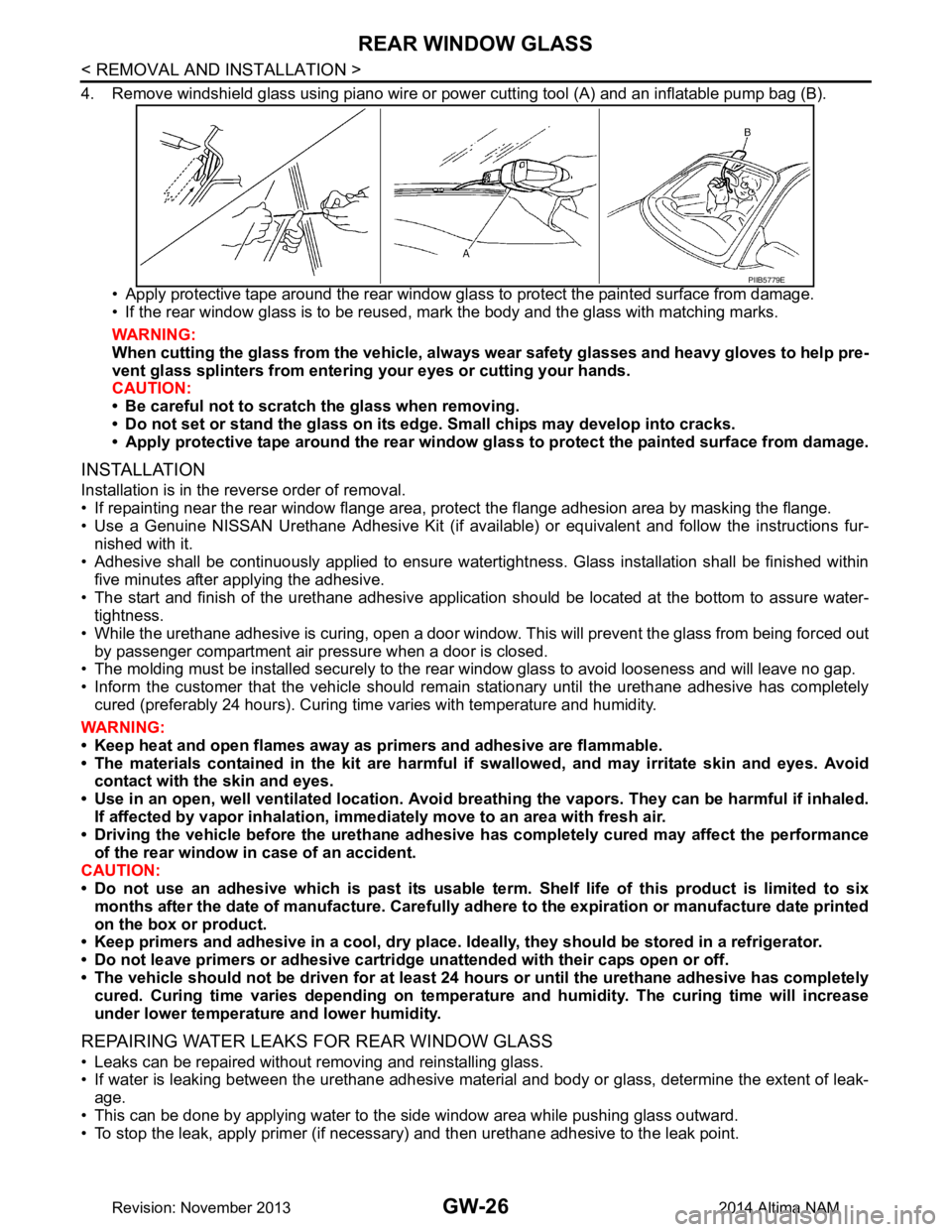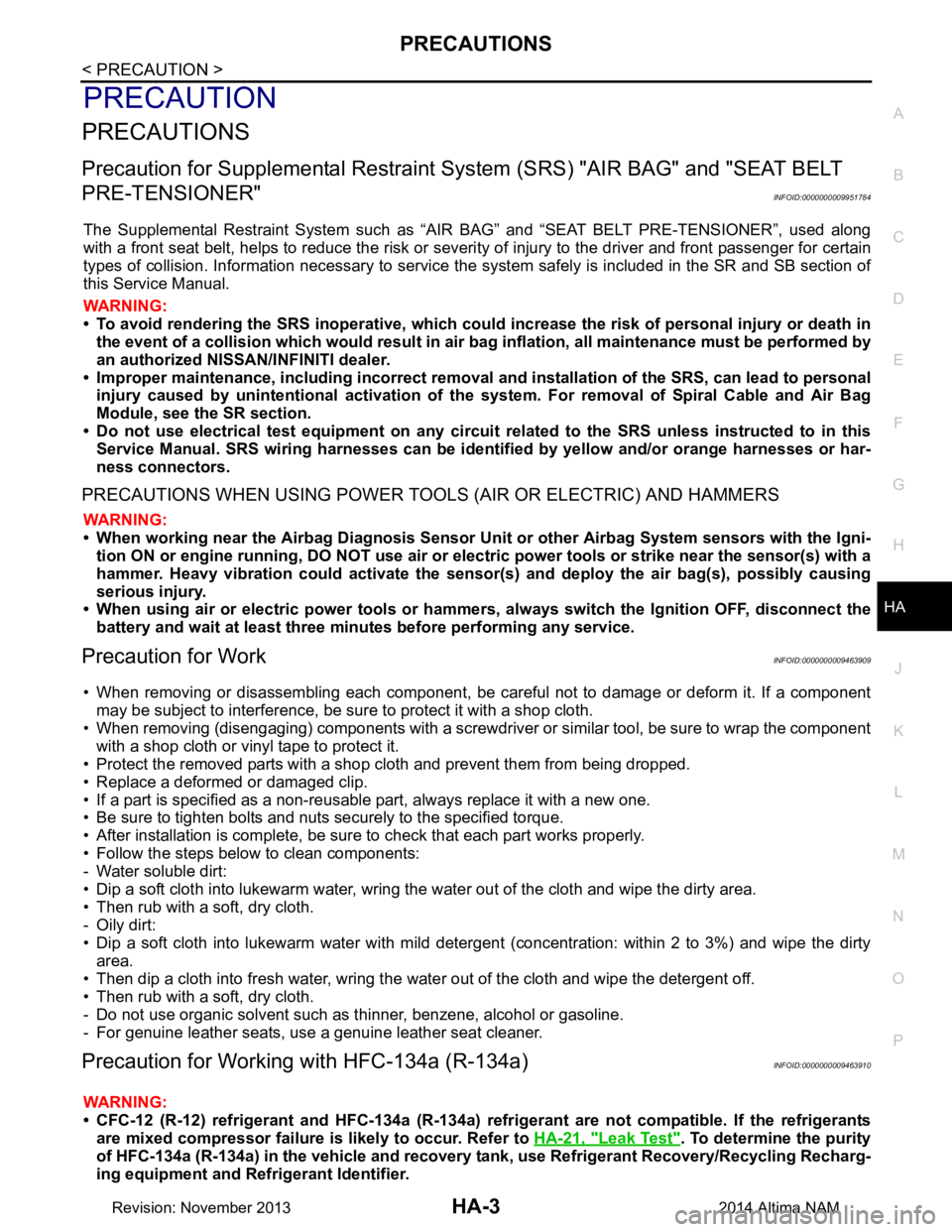2014 NISSAN TEANA ECU
[x] Cancel search: ECUPage 2606 of 4801

GW-26
< REMOVAL AND INSTALLATION >
REAR WINDOW GLASS
4. Remove windshield glass using piano wire or power cutting tool (A) and an inflatable pump bag (B).
• Apply protective tape around the rear window gla ss to protect the painted surface from damage.
• If the rear window glass is to be reused, mark the body and the glass with matching marks.
WARNING:
When cutting the glass from the vehicle, always wear safety glasses and heavy gloves to help pre-
vent glass splinters from entering your eyes or cutting your hands.
CAUTION:
• Be careful not to scratch the glass when removing.
• Do not set or stand the glass on its ed ge. Small chips may develop into cracks.
• Apply protective tape around th e rear window glass to protect the painted surface from damage.
INSTALLATION
Installation is in the reverse order of removal.
• If repainting near the rear window flange area, protect the flange adhesion area by masking the flange.
• Use a Genuine NISSAN Urethane Adhesive Kit (if availabl e) or equivalent and follow the instructions fur-
nished with it.
• Adhesive shall be continuously applied to ensure watert ightness. Glass installation shall be finished within
five minutes after applying the adhesive.
• The start and finish of the urethane adhesive application should be located at the bottom to assure water-
tightness.
• While the urethane adhesive is curing, open a door window . This will prevent the glass from being forced out
by passenger compartment air pressure when a door is closed.
• The molding must be installed securely to the rear window glass to avoid looseness and will leave no gap.
• Inform the customer that the vehicle should rema in stationary until the urethane adhesive has completely
cured (preferably 24 hours). Curing time varies with temperature and humidity.
WARNING:
• Keep heat and open flames away as primers and adhesive are flammable.
• The materials contained in the kit are harmful if swallowed, and may irritate skin and eyes. Avoid
contact with the skin and eyes.
• Use in an open, well ventilated location. Avoid br eathing the vapors. They can be harmful if inhaled.
If affected by vapor inhalation, imme diately move to an area with fresh air.
• Driving the vehicle before the urethane adhesive has completely cured may affect the performance
of the rear window in case of an accident.
CAUTION:
• Do not use an adhesive which is past its usable te rm. Shelf life of this product is limited to six
months after the date of manufacture. Carefully a dhere to the expiration or manufacture date printed
on the box or product.
• Keep primers and adhesive in a c ool, dry place. Ideally, they should be stored in a refrigerator.
• Do not leave primers or adhesive cartridge unattended with their caps open or off.
• The vehicle should not be driven for at least 24 hours or until the urethane adhesive has completely
cured. Curing time varies depe nding on temperature and humidity . The curing time will increase
under lower temperature and lower humidity.
REPAIRING WATER LEAKS FOR REAR WINDOW GLASS
• Leaks can be repaired without removing and reinstalling glass.
• If water is leaking between the urethane adhesive material and body or glass, determine the extent of leak-
age.
• This can be done by applying water to the side window area while pushing glass outward.
• To stop the leak, apply primer (if necessary) and then urethane adhesive to the leak point.
PIIB5779E
Revision: November 20132014 Altima NAM
Page 2609 of 4801

PRECAUTIONSHA-3
< PRECAUTION >
C
D E
F
G H
J
K L
M A
B
HA
N
O P
PRECAUTION
PRECAUTIONS
Precaution for Supplemental Restraint System (SRS) "AIR BAG" and "SEAT BELT
PRE-TENSIONER"
INFOID:0000000009951784
The Supplemental Restraint System such as “A IR BAG” and “SEAT BELT PRE-TENSIONER”, used along
with a front seat belt, helps to reduce the risk or severi ty of injury to the driver and front passenger for certain
types of collision. Information necessary to service t he system safely is included in the SR and SB section of
this Service Manual.
WARNING:
• To avoid rendering the SRS inoper ative, which could increase the risk of personal injury or death in
the event of a collision which would result in air bag inflation, all maintenance must be performed by
an authorized NISSAN/INFINITI dealer.
• Improper maintenance, including in correct removal and installation of the SRS, can lead to personal
injury caused by unintentional act ivation of the system. For removal of Spiral Cable and Air Bag
Module, see the SR section.
• Do not use electrical test equipm ent on any circuit related to the SRS unless instructed to in this
Service Manual. SRS wiring harnesses can be identi fied by yellow and/or orange harnesses or har-
ness connectors.
PRECAUTIONS WHEN USING POWER TOOLS (AIR OR ELECTRIC) AND HAMMERS
WARNING:
• When working near the Airbag Diagnosis Sensor Un it or other Airbag System sensors with the Igni-
tion ON or engine running, DO NOT use air or el ectric power tools or strike near the sensor(s) with a
hammer. Heavy vibration could activate the sensor( s) and deploy the air bag(s), possibly causing
serious injury.
• When using air or electric power tools or hammers , always switch the Ignition OFF, disconnect the
battery and wait at least three mi nutes before performing any service.
Precaution for WorkINFOID:0000000009463909
• When removing or disassembling each component, be ca reful not to damage or deform it. If a component
may be subject to interference, be sure to protect it with a shop cloth.
• When removing (disengaging) components with a screwdriver or similar tool, be sure to wrap the component with a shop cloth or vinyl tape to protect it.
• Protect the removed parts with a shop cloth and prevent them from being dropped.
• Replace a deformed or damaged clip.
• If a part is specified as a non-reusabl e part, always replace it with a new one.
• Be sure to tighten bolts and nuts securely to the specified torque.
• After installation is complete, be sure to check that each part works properly.
• Follow the steps below to clean components:
- Water soluble dirt:
• Dip a soft cloth into lukewarm water, wring the water out of the cloth and wipe the dirty area.
• Then rub with a soft, dry cloth.
-Oily dirt:
• Dip a soft cloth into lukewarm water with mild detergent (concentration: within 2 to 3%) and wipe the dirty area.
• Then dip a cloth into fresh water, wring the water out of the cloth and wipe the detergent off.
• Then rub with a soft, dry cloth.
- Do not use organic solvent such as thinner, benzene, alcohol or gasoline.
- For genuine leather seats, use a genuine leather seat cleaner.
Precaution for Workin g with HFC-134a (R-134a)INFOID:0000000009463910
WARNING:
• CFC-12 (R-12) refrigerant and HFC-134a (R-134a) refr igerant are not compatible. If the refrigerants
are mixed compressor failure is likely to occur. Refer to HA-21, "Leak Test"
. To determine the purity
of HFC-134a (R-134a) in the vehicle and recovery tank, use Refrigerant Recovery/Recycling Recharg-
ing equipment and Refrigerant Identifier.
Revision: November 20132014 Altima NAM
Page 2650 of 4801

HAC-1
VENTILATION, HEATER & AIR CONDITIONER
C
D E
F
G H
J
K L
M
SECTION HAC
A
B
HAC
N
O P
CONTENTS
HEATER & AIR CONDITIONING CONTROL SYSTEM
AUTOMATIC AIR CONDITIONER
PRECAUTION ................ ...............................
5
PRECAUTIONS .............................................. .....5
Precaution for Supplemental Restraint System
(SRS) "AIR BAG" and "SEAT BELT PRE-TEN-
SIONER" ............................................................. ......
5
Precaution for Work ..................................................5
Working with HFC-134a (R-134a) .............................5
Precaution for Service Equipment .............................6
PREPARATION ............................................8
PREPARATION .............................................. .....8
Special Service Tool ........................................... ......8
Commercial Service Tool ..........................................8
SYSTEM DESCRIPTION ..............................9
COMPONENT PARTS ................................... .....9
Component Part Location ................................... ......9
Component Description ...........................................10
SYSTEM .............................................................13
System Diagram .................................................. ....13
System Description .................................................13
Air Flow Control .......................................................14
Air Inlet Control .......................................................15
Air Outlet Control .....................................................16
Compressor Control ................................................16
Door Control ............................................................17
Temperature Control ...............................................20
Fail-safe ..................................................................20
OPERATION .......................................................21
Switch Name and Function ................................. ....21
DIAGNOSIS SYSTEM (A/C AUTO AMP.) .........24
CONSULT Function (HVAC) ............................... ....24
ECU DIAGNOSIS INFORMATION ..............28
A/C AUTO AMP. ...............................................28
Reference Value .................................................. ....28
DTC Inspection Priority Chart ...............................30
DTC Index ...............................................................31
ECM, IPDM E/R, BCM .......................................33
List of ECU Reference .............................................33
WIRING DIAGRAM ......................................34
AIR CONDITIONER CONTROL ........................34
Wiring Diagram .................................................... ....34
BASIC INSPECTION ...................................46
DIAGNOSIS AND REPAIR WORKFLOW ........46
Work Flow ............................................................ ....46
OPERATION INSPECTION ..............................48
Work Procedure .......................................................48
SYSTEM SETTING ...........................................50
Temperature Setting Trimmer ............................. ....50
Foot Position Setting Trimmer .................................50
Inlet Port Memory Function (FRE) ...........................50
Inlet Port Memory Function (REC) ..........................51
Target Evaporator Temp Upper Limit ......................51
ADDITIONAL SERVICE WHEN REPLACING
CONTROL UNIT (A/C AUTO AMP.) .................
52
Description ........................................................... ....52
Work Procedure .......................................................52
CONFIGURATION (HVAC) ...............................53
Description ...............................................................53
Work Procedure .......................................................53
Configuration List .....................................................54
DTC/CIRCUIT DIAGNOSIS .........................55
U1000 CAN COMM CIRCUIT ...........................55
Description ........................................................... ....55
DTC Logic ................................................................55
Revision: November 20132014 Altima NAMRevision: November 20132014 Altima NAM
Page 2652 of 4801

HAC-3
C
D E
F
G H
J
K L
M A
B
HAC
N
O P
AMBIENT SENSOR ....................................... ..103
Removal and Installation .......................................103
IN-VEHICLE SENSOR ................................... ..104
Removal and Installation .......................................104
SUNLOAD SENSOR ...................................... ..105
Removal and Installation .......................................105
INTAKE SENSOR .......................................... ..106
Removal and Installation .......................................106
REFRIGERANT PRESSURE SENSOR ......... ..107
Removal and Installation .......................................107
DOOR MOTOR ............................................... ..108
Exploded View .................................................... ..108
INTAKE DOOR MOTOR ........................................ ..109
INTAKE DOOR MOTOR : Removal and Installa-
tion ...................................................................... ..
109
MODE DOOR MOTOR .......................................... ..109
MODE DOOR MOTOR : Removal and Installation ..109
AIR MIX DOOR MOTOR ....................................... ..109
AIR MIX DOOR MOTOR : Removal and Installa-
tion - Air Mix Door Motor (RH) ............................. ..
109
AIR MIX DOOR MOTOR : Removal and Installa-
tion - Air Mix Door Motor (LH) ............................. ..
109
MANUAL AIR CONDITIONER
PRECAUTION ................ ............................
110
PRECAUTIONS .............................................. ..110
Precaution for Supplemental Restraint System
(SRS) "AIR BAG" and "SEAT BELT PRE-TEN-
SIONER" ............................................................. ..
110
Precaution for Work ..............................................110
Working with HFC-134a (R-134a) .........................110
Precaution for Service Equipment .........................111
PREPARATION .........................................113
PREPARATION .............................................. ..113
Special Service Tool ........................................... ..113
Commercial Service Tool ......................................113
SYSTEM DESCRIPTION ...........................114
COMPONENT PARTS ................................... ..114
Component Part Location ................................... ..114
Component Description .........................................115
SYSTEM ...........................................................117
System Diagram .................................................. ..117
System Description ...............................................117
Air Flow Control .....................................................118
Air Inlet Control .....................................................118
Air Outlet Control ...................................................118
Compressor Control ..............................................118
Door Control ..........................................................119
Temperature Control ........................................... ..121
OPERATION ...................................................122
Switch Name and Function ....................................122
DIAGNOSIS SYSTEM (BCM) .........................124
CONSULT Function (BCM - COMMON ITEM) ......124
CONSULT Function (BCM - AIR CONDITIONER) ..125
DIAGNOSIS SYSTEM (IPDM E/R) .................126
CONSULT Function (IPDM E/R) ...........................126
ECU DIAGNOSIS INFORMATION ............128
FRONT AIR CONTROL ..................................128
Reference Value .................................................. ..128
ECM, IPDM E/R, BCM .....................................129
List of ECU Reference ...........................................129
WIRING DIAGRAM ....................................130
AIR CONDITIONER CONTROL ......................130
Wiring Diagram .................................................... ..130
BASIC INSPECTION .................................139
DIAGNOSIS AND REPAIR WORKFLOW ......139
Work Flow ............................................................ ..139
OPERATION INSPECTION ............................140
Work Procedure .....................................................140
DTC/CIRCUIT DIAGNOSIS .......................142
MODE DOOR MOTOR ....................................142
Diagnosis Procedure ........................................... ..142
AIR MIX DOOR MOTOR .................................144
Diagnosis Procedure .............................................144
INTAKE DOOR MOTOR .................................146
Diagnosis Procedure .............................................146
BLOWER MOTOR ..........................................148
Diagnosis Procedure .............................................148
Component Inspection (Blower Motor) ..................149
Component Inspection (Front Blower Motor Re-
lay) ....................................................................... ..
149
MAGNET CLUTCH .........................................151
Component Function Check ..................................151
Diagnosis Procedure .............................................151
POWER SUPPLY AND GROUND CIRCUIT
FOR FRONT AIR CONTROL ..........................
152
Description ........................................................... ..152
Component Function Check ..................................152
Diagnosis Procedure .............................................152
SYMPTOM DIAGNOSIS ............................154
Revision: November 20132014 Altima NAMRevision: November 20132014 Altima NAM
Page 2654 of 4801
![NISSAN TEANA 2014 Service Manual
PRECAUTIONSHAC-5
< PRECAUTION > [AUTOMATIC AIR CONDITIONER]
C
D E
F
G H
J
K L
M A
B
HAC
N
O P
PRECAUTION
PRECAUTIONS
Precaution for Supplemental Restraint System (SRS) "AIR BAG" and "SEAT BELT
PR NISSAN TEANA 2014 Service Manual
PRECAUTIONSHAC-5
< PRECAUTION > [AUTOMATIC AIR CONDITIONER]
C
D E
F
G H
J
K L
M A
B
HAC
N
O P
PRECAUTION
PRECAUTIONS
Precaution for Supplemental Restraint System (SRS) "AIR BAG" and "SEAT BELT
PR](/manual-img/5/57390/w960_57390-2653.png)
PRECAUTIONSHAC-5
< PRECAUTION > [AUTOMATIC AIR CONDITIONER]
C
D E
F
G H
J
K L
M A
B
HAC
N
O P
PRECAUTION
PRECAUTIONS
Precaution for Supplemental Restraint System (SRS) "AIR BAG" and "SEAT BELT
PRE-TENSIONER"
INFOID:0000000009951773
The Supplemental Restraint System such as “A IR BAG” and “SEAT BELT PRE-TENSIONER”, used along
with a front seat belt, helps to reduce the risk or severi ty of injury to the driver and front passenger for certain
types of collision. Information necessary to service t he system safely is included in the SR and SB section of
this Service Manual.
WARNING:
• To avoid rendering the SRS inoper ative, which could increase the risk of personal injury or death in
the event of a collision which would result in air bag inflation, all maintenance must be performed by
an authorized NISSAN/INFINITI dealer.
• Improper maintenance, including in correct removal and installation of the SRS, can lead to personal
injury caused by unintentional act ivation of the system. For removal of Spiral Cable and Air Bag
Module, see the SR section.
• Do not use electrical test equipm ent on any circuit related to the SRS unless instructed to in this
Service Manual. SRS wiring harnesses can be identi fied by yellow and/or orange harnesses or har-
ness connectors.
PRECAUTIONS WHEN USING POWER TOOLS (AIR OR ELECTRIC) AND HAMMERS
WARNING:
• When working near the Airbag Diagnosis Sensor Un it or other Airbag System sensors with the Igni-
tion ON or engine running, DO NOT use air or el ectric power tools or strike near the sensor(s) with a
hammer. Heavy vibration could activate the sensor( s) and deploy the air bag(s), possibly causing
serious injury.
• When using air or electric power tools or hammers , always switch the Ignition OFF, disconnect the
battery and wait at least three mi nutes before performing any service.
Precaution for WorkINFOID:0000000009463086
• When removing or disassembling each component, be ca reful not to damage or deform it. If a component
may be subject to interference, be sure to protect it with a shop cloth.
• When removing (disengaging) components with a screwdriver or similar tool, be sure to wrap the component with a shop cloth or vinyl tape to protect it.
• Protect the removed parts with a shop cloth and prevent them from being dropped.
• Replace a deformed or damaged clip.
• If a part is specified as a non-reusabl e part, always replace it with a new one.
• Be sure to tighten bolts and nuts securely to the specified torque.
• After installation is complete, be sure to check that each part works properly.
• Follow the steps below to clean components:
- Water soluble dirt:
• Dip a soft cloth into lukewarm water, wring the water out of the cloth and wipe the dirty area.
• Then rub with a soft, dry cloth.
-Oily dirt:
• Dip a soft cloth into lukewarm water with mild detergent (concentration: within 2 to 3%) and wipe the dirty area.
• Then dip a cloth into fresh water, wring the water out of the cloth and wipe the detergent off.
• Then rub with a soft, dry cloth.
- Do not use organic solvent such as thinner, benzene, alcohol or gasoline.
- For genuine leather seats, use a genuine leather seat cleaner.
Working with HFC-134a (R-134a)INFOID:0000000009463087
WARNING:
• CFC-12 (R-12) refrigerant and HFC-134a (R-134a) refr igerant are not compatible. If the refrigerants
are mixed compressor failure is likely to occur. Refer to HA-25, "Inspection"
. To determine the purity
of HFC-134a (R-134a) in the vehicle and recovery tank, use Refrigerant Recovery/Recycling Recharg-
ing equipment and Refrigerant Identifier.
Revision: November 20132014 Altima NAMRevision: November 20132014 Altima NAM
Page 2673 of 4801
![NISSAN TEANA 2014 Service Manual
HAC-24
< SYSTEM DESCRIPTION >[AUTOMATIC AIR CONDITIONER]
DIAGNOSIS SYSTEM
(A/C AUTO AMP.)
DIAGNOSIS SYSTEM (A/C AUTO AMP.)
CONSULT Function (HVAC)INFOID:0000000009463103
CAUTION:
After disconnectin NISSAN TEANA 2014 Service Manual
HAC-24
< SYSTEM DESCRIPTION >[AUTOMATIC AIR CONDITIONER]
DIAGNOSIS SYSTEM
(A/C AUTO AMP.)
DIAGNOSIS SYSTEM (A/C AUTO AMP.)
CONSULT Function (HVAC)INFOID:0000000009463103
CAUTION:
After disconnectin](/manual-img/5/57390/w960_57390-2672.png)
HAC-24
< SYSTEM DESCRIPTION >[AUTOMATIC AIR CONDITIONER]
DIAGNOSIS SYSTEM
(A/C AUTO AMP.)
DIAGNOSIS SYSTEM (A/C AUTO AMP.)
CONSULT Function (HVAC)INFOID:0000000009463103
CAUTION:
After disconnecting the CONSULT vehicle interface (VI) from the data link connector, the ignition must
be cycled OFF → ON (for at least 5 seconds) → OFF. If this step is not performed, the BCM may not go
to ”sleep mode”, potentially causing a di scharged battery and no-start condition.
CONSULT can display each diagnosis item us ing the diagnosis test modes as shown.
CONSULT application items
SELF-DIAGNOSTIC RESULT
Refer to HAC-31, "DTC Index".
Display Item List
Diagnosis mode Description
Self-Diagnostic Result Displays the diagnosis results judged by A/C auto amp.
Data Monitor Displays A/C auto amp. input/output data in real time.
Work support Changes the setting for each system function.
Active Test The signals used to activate each device are forcibly supplied from A/C auto amp.
ECU Identification Displays the A/C auto amp. number.
Configuration • The vehicle specification can be read and saved.
• The vehicle specification can be written when replacing A/C auto amp.
DTC Items
(CONSULT screen terms) Diagnostic item is detected when... Possible cause
U1000 CAN COMM CIRCUIT When A/C auto amp. is not transmitting
or receiving CAN communication signal
for 2 or more seconds. CAN communication system
U1010 CONTROL UNIT (CAN) When detecting error during the initial
diagnosis of CAN controller of A/C auto
amp. A/C auto amp.
B257B AMB TEMP SEN (SHORT) Detected temperature at ambient sen-
sor 55 °C (131 °F) or more • Ambient sensor
• A/C auto amp.
• Harness and connector (Ambient sensor circuit is open,
or there is a short in the circuit)
B257C AMB TEMP SEN (OPEN)
Detected temperature at ambient sen-
sor −30 °C ( −22 °F) or less
B2578 IN-CAR SENSOR (OUT OF RANGE
[LOW]) Detected temperature at in-vehicle sen-
sor 55 °C (131 °F) or more • In-vehicle sensor
• A/C auto amp.
• Harness and connector (In-vehicle sensor circuit is open,
or there is a short in the circuit)
B2579
IN-CAR SENSOR (OUT OF RANGE
[HI]) Detected temperature at in-vehicle sen-
sor −30 °C ( −22 °F) or less
B2581 EVAP TEMP SEN (SHORT) Detected temperature at intake sensor
55 °C (131 °F) or more • Intake sensor
• A/C auto amp.
• Harness and connector
(Intake sensor circuit is open, or
there is a short in the circuit)
B2582 EVAP TEMP SEN (OPEN)
Detected temperature at intake sensor
− 30 °C ( −22 °F) or less
B2630
*SUNLOAD SEN (SHORT) Detected calorie at sunload sensor
1395 w/m2 (1200 kcal/m2·h) • Sunload sensor
• A/C auto amp.
• Harness and connector (Sunload sensor circuit is open,
or there is a short in the circuit)
B2631
*SUNLOAD SEN (OPEN) Detected calorie at sunload sensor 0 w/
m2 (0 kcal/m2·h)
Revision: November 20132014 Altima NAMRevision: November 20132014 Altima NAM
Page 2676 of 4801
![NISSAN TEANA 2014 Service Manual
DIAGNOSIS SYSTEM (A/C AUTO AMP.)HAC-27
< SYSTEM DESCRIPTION > [AUTOMATIC AIR CONDITIONER]
C
D E
F
G H
J
K L
M A
B
HAC
N
O P
NOTE:
Perform the inspection of each output device after starting the en NISSAN TEANA 2014 Service Manual
DIAGNOSIS SYSTEM (A/C AUTO AMP.)HAC-27
< SYSTEM DESCRIPTION > [AUTOMATIC AIR CONDITIONER]
C
D E
F
G H
J
K L
M A
B
HAC
N
O P
NOTE:
Perform the inspection of each output device after starting the en](/manual-img/5/57390/w960_57390-2675.png)
DIAGNOSIS SYSTEM (A/C AUTO AMP.)HAC-27
< SYSTEM DESCRIPTION > [AUTOMATIC AIR CONDITIONER]
C
D E
F
G H
J
K L
M A
B
HAC
N
O P
NOTE:
Perform the inspection of each output device after starting the engine, because the A/C compressor has been operating.
CONFIGURATION
Configuration includes the following functions.
CAUTION:
Use ‘‘Manual Configuration’’ only when ‘‘TY PE ID’’ of A/C auto amp. cannot be read.
Blower motor duty ratio 30% 30% 60% HI HI 60% HI
A/C compressor (Mag-
net clutch) ON ON ON OFF OFF ON ON
ECV duty 100% 100% 50% 0% 0% 100% 100% Te s t i t e m
MODE 1 MODE 2 MODE 3 MODE 4 MODE 5 MODE 6 MODE 7
Function Description
Read/Write Configuration Before replacing ECU
Allows the reading of vehicle specification (Type ID) written in A/C
auto amp. to store the specification in CONSULT.
After replacing ECU Allows the writing of vehicle information (Type ID) stored in CON-
SULT into the A/C auto amp.
Manual Configuration Allows the writing of vehicle specification (Type ID) into the A/C
auto amp. by hand.
Revision: November 20132014 Altima NAMRevision: November 20132014 Altima NAM
Page 2677 of 4801
![NISSAN TEANA 2014 Service Manual
HAC-28
< ECU DIAGNOSIS INFORMATION >[AUTOMATIC AIR CONDITIONER]
A/C AUTO AMP.
ECU DIAGNOSIS INFORMATION
A/C AUTO AMP.
Reference ValueINFOID:0000000009463104
VALUES ON THE DIAGNOSIS TOOL
TERMINAL LAY NISSAN TEANA 2014 Service Manual
HAC-28
< ECU DIAGNOSIS INFORMATION >[AUTOMATIC AIR CONDITIONER]
A/C AUTO AMP.
ECU DIAGNOSIS INFORMATION
A/C AUTO AMP.
Reference ValueINFOID:0000000009463104
VALUES ON THE DIAGNOSIS TOOL
TERMINAL LAY](/manual-img/5/57390/w960_57390-2676.png)
HAC-28
< ECU DIAGNOSIS INFORMATION >[AUTOMATIC AIR CONDITIONER]
A/C AUTO AMP.
ECU DIAGNOSIS INFORMATION
A/C AUTO AMP.
Reference ValueINFOID:0000000009463104
VALUES ON THE DIAGNOSIS TOOL
TERMINAL LAYOUT
PHYSICAL VALUES
Monitor item Condition Value/Status
AMB TEMP SEN Ignition switch ON — 22 - 131 °F ( −30 - 55 °C)
IN-VEH TEMP Ignition switch ON — 22 - 131 °F ( −30 - 55 °C)
INT TEMP SEN Ignition switch ON — 22 - 131 °F ( −30 - 55 °C)
SUNLOAD SEN Ignition switch ON — 0 - 1395 w/m
2
(0 - 1200 kcal/m2·h)
AMB SEN CAL Ignition switch ON — 22 -131 °F ( −30 - 55 °C)
IN-VEH CAL Ignition switch ON — 22 -131 °F ( −30 - 55 °C)
INT TEMP CAL Ignition switch ON — 22 -131 °F ( −30 - 55 °C)
SUNL SEN CAL Ignition switch ON — 0 - 1395 w/m
2
(0 - 1200 kcal/m2·h)
COMP REQ SIG Engine: Run at idle after
warming up A/C switch: ON
(A/C compressor operation
status) On
A/C switch: OFF Off
FAN REQ SIG Engine: Run at idle after
warming up Blower fan: ON On
Blower fan: OFF Off
FAN DUTY Engine: Run at idle after
warming up Blower fan: ON 25 - 85%
Blower fan: OFF 0%
XM Ignition switch ON — −100 - 155
PA TARGET A/TEMP Ignition switch ON — Value according to target air
flow temperature (passen-
ger side)
ENG COOL TEMP Ignition switch ON — Values according to coolant
temperature
VEHICLE SPEED Driving — Equivalent to speedometer
reading
ALIIA0579ZZ
Revision: November 20132014 Altima NAMRevision: November 20132014 Altima NAM